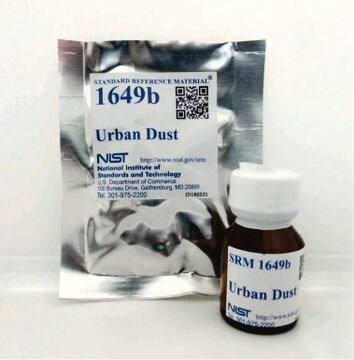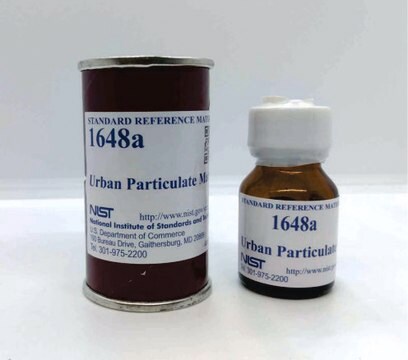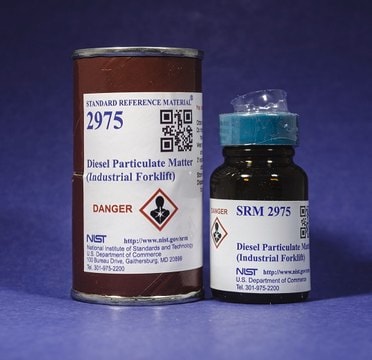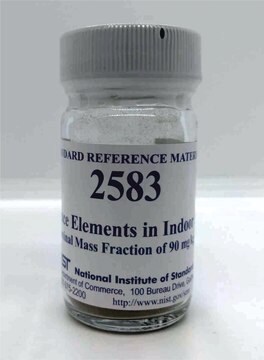NIST2786
Fine particulate matter
NIST® SRM® 2786, <4 μm
Faça loginpara ver os preços organizacionais e de contrato
About This Item
Código UNSPSC:
41116107
NACRES:
NA.24
Produtos recomendados
grau
certified reference material
Nível de qualidade
embalagem
pkg of 1 bottle
fabricante/nome comercial
NIST®
aplicação(ões)
industrial hygiene
formato
matrix material
Procurando produtos similares? Visita Guia de comparação de produtos
Categorias relacionadas
Descrição geral
This Standard Reference Material (SRM) is intended for use in evaluating analytical methods for the determination of selected polycyclic aromatic hydrocarbons (PAHs), nitro-substituted PAHs (nitro-PAHs), polybrominated diphenyl ether (PBDE) congeners, hexabromocyclododecane (HBCD) isomers, sugars, polychlorinated dibenzo-p-dioxin (PCDD) and dibenzofuran (PCDF) congeners, inorganic constituents, and particle-size characteristics in atmospheric particulate material and similar matrices. A unit of SRM 2786 consists of one bottle containing between 100 mg and 140 mg of particulate matter. For more information, please refer to the SDS and COA.
SRM 2786_cert
SRM 2786_SDS
SRM 2786_cert
SRM 2786_SDS
Aplicação
- Pediatric respiratory health in sparsely populated areas: Research demonstrates that seasonal extreme temperatures and short-term increases in fine particulate matter significantly impact pediatric respiratory health in the intermountain western United States, underscoring the need for tailored environmental health strategies in rural settings (Landguth et al., 2024).
- Oxidative potential of PM2.5 in urban environments: A study identifies major source categories of PM2.5 oxidative potential in wintertime Beijing, utilizing online dithiothreitol-based field measurements to enhance understanding of air pollution dynamics and health risks in heavily populated urban areas (Cheung et al., 2024).
- Impact of fine particulate matter on COVID-19: Analysis in Bangkok during 2020-2021 links fine particulate matter and meteorological factors with the daily confirmed cases of COVID-19, offering insights into the complex interactions between air quality and public health crises (Sangkham et al., 2023).
- Global assessment of air quality risks: A comprehensive study provides a global status and risk assessment of PM2.5 and O3 pollution based on the new WHO air quality guidelines, proposing pathways to achieve better and healthier air quality worldwide (Liu et al., 2024).
- Personal exposure monitoring in elderly populations: This research focuses on the personal exposure of elderly residents to fine and coarse particulate matter in Hong Kong, employing exposure assessment models to evaluate individual health risks associated with urban air pollution (Lui et al., 2024).
Informações legais
NIST is a registered trademark of National Institute of Standards and Technology
SRM is a registered trademark of National Institute of Standards and Technology
produto relacionado
Nº do produto
Descrição
Preços
Código de classe de armazenamento
13 - Non Combustible Solids
Classe de risco de água (WGK)
WGK 3
Ponto de fulgor (°F)
Not applicable
Ponto de fulgor (°C)
Not applicable
Escolha uma das versões mais recentes:
Certificados de análise (COA)
Lot/Batch Number
Lamentamos, não temos COA para este produto disponíveis online no momento.
Se precisar de ajuda, entre em contato Atendimento ao cliente
Já possui este produto?
Encontre a documentação dos produtos que você adquiriu recentemente na biblioteca de documentos.
Os clientes também visualizaram
Dong Chang Lee et al.
Toxics, 9(2) (2021-03-07)
Eupatilin is an active flavon extracted from the Artemisia species and has properties such as antioxidant, anti-inflammatory, and anti-cancer. We examined the effect of eupatilin using fine particulate matter (FPM) and human bronchial epithelial cell line (BEAS-2B) to confirm the
Nossa equipe de cientistas tem experiência em todas as áreas de pesquisa, incluindo Life Sciences, ciência de materiais, síntese química, cromatografia, química analítica e muitas outras.
Entre em contato com a assistência técnica










